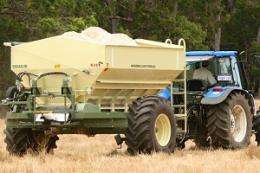Roesner released a spreader with a new design 18 months ago and commissioned expert scientific research from CSIRO to validate its effectiveness. Credit: Roesner Pty Ltd
The nation's biggest supplier of fertiliser spreaders is using research by CSIRO to show farmers that even fertiliser distribution can help them improve crop yields.
Harvey-based fertiliser spreader manufacturer Roesner Pty Ltd and researchers from CSIRO Ecosystem Sciences in Perth collaborated to develop a computer-based tool that explores the impact of different fertiliser spread patterns over a typical range of soil and season types.
The research, undertaken by CSIRO researchers David Gobbett and Michael Robertson, was presented at the 16th Precision Agriculture Symposium in Perth this week.
Their tool uses Microsoft Excel and Visual Basic for Applications code and merges modelling for wheat crop response to nitrogen fertiliser, with simulations of fertiliser application based on driving patterns and spread patterns.
Mr Gobbett says the tool was not intended for making fertiliser application decisions in any specific cases, but rather as means to investigate the relationship between nitrogen fertiliser, bout width (the width of the spreader), soil quality and season type.
Testing involved modelling crop yield and economic returns for soils with different background nitrogen levels and a range of spread patterns, together with different soil and season types.
"The tool was developed iteratively, with several versions evaluated and tested by Roesner in the course of its development," Mr Gobbett says.
"We found the impact of wider bout widths and consequently less even fertilisers spread, is greatest when background nitrogen is low and when high levels of fertilisers are applied.
"In these cases poor distribution of fertilisers resulted in yield losses.
"When the background nitrogen is higher, the negative impact of poor distribution is reduced."
The report says the findings reinforce the importance of farmers understanding their background soil nitrogen levels before making decisions about fertiliser application rates.
Roesner makes the Marshall Multispread fertiliser spreader; there are 8000 operating across Australia representing an 80 per cent market share.
Roesner technical director Matt Roesner says the company released a spreader with a new design 18 months ago and commissioned expert scientific research from CSIRO to validate its effectiveness.
He says the spread width had been increased in the new model and it was more accurate in its distribution.
Mr Roesner says if a farmer chooses wider bout widths it may mean less time and fuel spent in applying fertiliser, but using too wide-a-bout-width could mean the economic returns from the crop are reduced.
"The decision on bout width and driving pattern should also take soil quality and season type into account, as the research's sensitivity analysis shows.
"The benefits to farmers will come from better understanding how these factors interact across a range of soil and season types."
Provided by Science Network WA




















